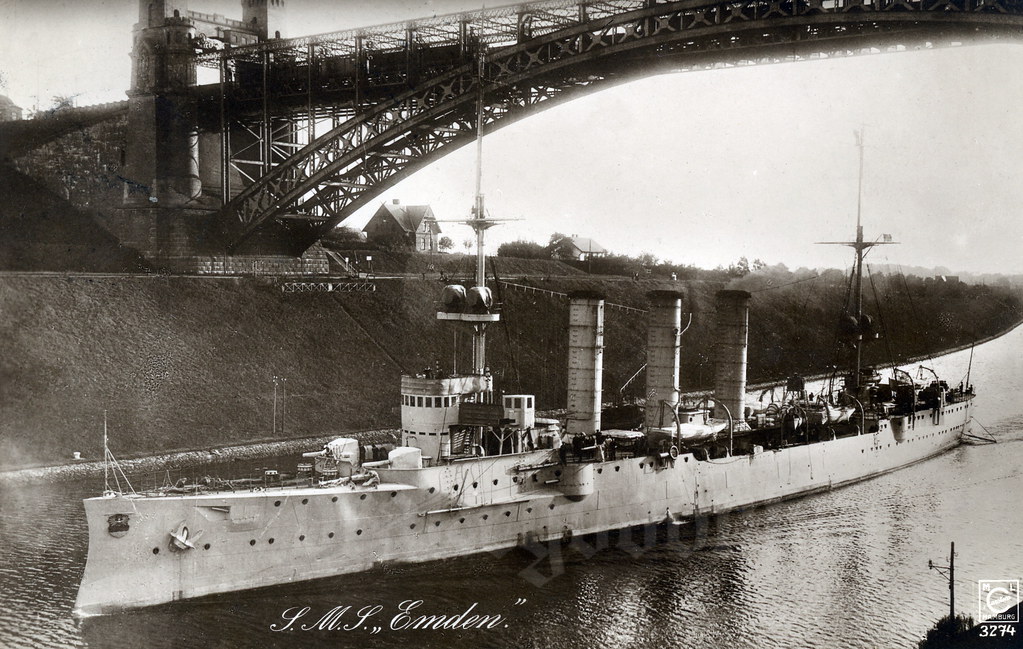#Hellmuth von Mücke
Text
Emden spent the majority of her career overseas in the German East Asia Squadron, based in Tsingtao, in the Kiautschou Bay concession in China. In 1913, Karl von Müller took command of the ship. At the outbreak of World War I, Emden captured a Russian steamer and converted her into the commerce raider Cormoran. Emden rejoined the East Asia Squadron, then was detached for independent raiding in the Indian Ocean. The cruiser spent nearly two months operating in the region, and captured nearly two dozen ships. On 28 October 1914, Emden launched a surprise attack on Penang; in the resulting Battle of Penang, she sank the Russian cruiser Zhemchug and the French destroyer Mousquet.
Müller then took Emden to raid the Cocos Islands, where he landed a contingent of sailors to destroy British facilities. There, Emden was attacked by the Australian cruiser HMAS Sydney on 9 November 1914. The more powerful Australian ship quickly inflicted serious damage and forced Müller to run his ship aground to avoid sinking. Out of a crew of 376, 133 were killed in the battle. Most of the survivors were taken prisoner; the landing party, led by Hellmuth von Mücke, commandeered an old schooner and eventually returned to Germany. Emden's wreck was quickly destroyed by wave action, and was broken up for scrap in the 1950s


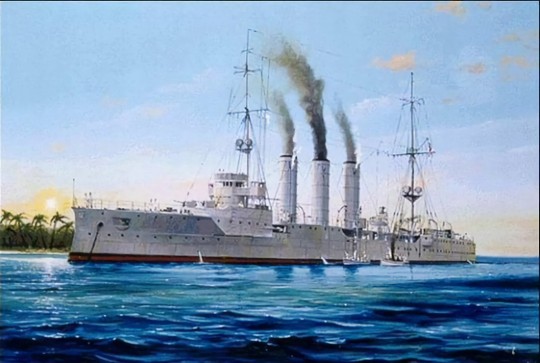



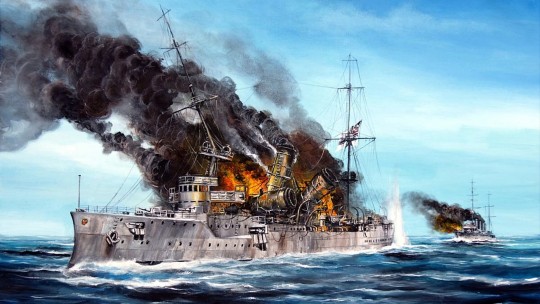
#theredcomet#art on tumblr#makoforpresident#fanart#original art#vote for mako#military art#warship#ww2 art#wwii art#ww2#wwii#naval art#wwii history#wwii aircraft#history#wwiart#wwi#ww1 history
3 notes
·
View notes
Text
On This Day...

On this day in 1914, the German light cruiser SMS Emden was defeated by the Australian light cruiser HMAS Sydney in the Battle of Cocos Islands in the Indian Ocean. The Emden had been commerce raiding throughout the Indian Ocean and the Java Sea since the outbreak of war in August. Sydney was part of an escort of Australian and Japanese warships escorting the first large contingent of Australian and New Zealander troops to Europe when she was detached and ordered to hunt down the Emden after the German warship was detected in the Cocos Islands. The larger and better armed Sydney made quick work of Emden, causing serious damage and inflicting heavy casualties on the crew. The Emden’s captain eventually beached the warship intentionally in order to prevent her from sinking. The last German warship in the Pacific was defeated, allowing the Allies to concentrate their naval power elsewhere on the map. The battle, however, was not the end of the story for a part of Emden’s crew, but was rather only the beginning of an epic worthy of Odysseus and Xenophon.
At the start of the First World War in August 1914, Emden was assigned to the German East Asia Squadron, based in the northern Chinese city of Tsingtao (now Qingdao)*. The East Asia Squadron’s role was to pose a threat to the economic interests of Britain and France in their Asian colonies on the outbreak of any war. In essence it was designed to be a commerce raiding force. The concept of commerce raiding was espoused by the German navy in both world wars and was based on the concept that, when faced with an enemy or combination of enemies who possessed superior naval forces, Germany should resort to a form of naval guerilla warfare: using smaller, faster warships in other parts of the globe to attack your enemies’ vulnerable economic lifelines. This concept works well in theory, but in practice it was a much more reasonable strategy for U-boats, submarines, than for surface warfare units. While several German warships managed to cause some trouble for Britain and France, they were eventually, inevitably, hunted down and destroyed by superior Allied warships. This story repeated itself, albeit on much grander scale, in the Second World War when the German battleship Bismarck was deployed in the Atlantic to attack lightly protected merchant convoys to the British Isles, but was almost immediately hunted and destroyed by the British Home Fleet.
While it would later prove a spectacular failure, German commerce raiders were initially successful in 1914. After the entry of Japan into the war in late August 1914, the position of the East Asia Squadron in Tsingtao became untenable. The small East Asia Squadron was no match for the Japan’s modern fleet of fast and heavily armed battleships and so the German commander, Vice Admiral Cont Maximilian von Spee, decided he would attempt to cross the Pacific, then the Atlantic and then either join with the German Mediterranean squadron--soon to be blockaded in the Ottoman capital of Constantinople, the sequence of events leading up to that are an epic story unto itself--or into the north Atlantic where they would try to sneak through the British blockade in the North Sea to join the main German High Seas Fleet in the Baltic. Spee knew his chances of success were low, but to stay in the Pacific invited battle with superior Japanese forces. After a cat and mouse chase with Japanese and Australian warships across the Pacific, Spee surprised an inferior British squadron off Coronel, Chile on November 1 and destroyed it, killing the British admiral commanding. Spee and the East Asia Squadron met their end six weeks later when they were in turn surprised by a superior British squadron in the Falkland Islands in the south Atlantic; Spee went down with his flagship.
Before deciding to cross the Pacific, Spee was able to get a message to Emden, which was detached from the rest of the East Asia Squadron, and ordered it to begin commerce raiding. Emden, commanded by Captain Karl von Müller, begin its mission on September 22, by bombarding the harbor and oil facilities in the Indian port of Madras, causing heavy damage. On October 28, Emden, disguised as a British lighter cruiser, sneaked into the harbor of Penang on the Strait of Malacca, attacked and sank a Russian cruiser and a French destroyer. In Europe, the war was raging and the need for reinforcements by the Allies prompted Australia and New Zealand to assemble large contingents of troops that would be convoyed along with Indian troops around the globe to fight the Germans in northwest Europe. Senior Allied commanders were concerned that, not only was Emden damaging morale by through its harassing actions around the Indian Ocean, but that it might attempt to interdict these troop convoys. This concern prompted Australia, New Zealand, and Japan to assign warships to protect these convoys as far as the Red Sea. After transiting the Red Sea, the convoys would be safe, as the British and French Mediterranean Fleets dominated that inland ocean.
Emden’s captain, Müller, in order to hamper Allied communications in the region, next targeted Direction Island in the Cocos and Keeling Island Group. The British maintained a large wireless radio transmitter on the island and its destruction would make it difficult for any warships hunting Emden to coordinate their actions by radio. As Emden approached Direction Island, a landing party was assembled under Lt. Hellmuth von Mücke, to go ashore and destroy the transmitter. It was while Mücke and his party were ashore that Sydney approached Emden and initiated a gun duel. Mücke and his men watched helplessly as the Sydney pummeled Emden, forcing Müller to intentionally beach his ship to prevent it sinking and even greater loss of life.
Finding themselves abruptly stranded on Direction Island and wary of a potential landing party from Sydney coming ashore to take the Germans prisoner, Mücke with 51 officers, sailors, and marines, boarded the schooner Ayesha that was anchored in the island’s lagoon, and took it a prize. With his makeshift crew, Mücke sailed the Ayesha away in the opposite direction of Sydney.
The Ayesha arrived in the port of Padang, on the island of Sumatra, on December 27. Sumatra, at the time, was part of the Netherland’s vast East Asian colonial empire, but the Dutch were also neutrals in the war and, as Ayesha was now officially a part of the Imperial German Navy, Mücke was permitted to stay in harbor for only 24 hours. Before departing Padang on December 28, Mücke quietly communicated to some German merchant vessels taking shelter in the harbor, that he would sail to a rendezvous point several miles out to sea and that any merchant ship which could provide supplies to him, should meet the Ayesha there. On the 28th, Ayesha met up with the German freighter Choising and transferred his command over to the civilian ship, abandoning the Ayesha. Choising delivered the Germans to the port of Al Hudaydah on the Red Sea coast of Yemen, then a part of the Ottoman Empire.
After making contact with local Ottoman officials, Mücke communicated his intention to return to Germany and requested Ottoman assistance in doing so. Ottoman leaders in Sana'a delayed and so a frustrated Mücke marched his men back to Al Hudaydah where they hired two local sambuks to sail them up the Red Sea coast. By now, it was March 1915; Mücke and his men had been on the lam for over four months. One sambuk struck a coral reef and sank with no loss of life. The Germans crowded onto the remaining sambuk and arrived three days later at Al Qunfudhah, where a new ship was chartered. This larger vessel transported them to Al Lith, where one German died of typhus. Through this entire ordeal, Mücke had not lost a single man in battle or to disease.
The Germans set out overland for the city of Jeddah on March 30, escorted by Turkish and Arab guards who were ostensibly supposed to protect Mücke’s command from Bedouin tribes. Sure enough, Bedouin raiders appeared and the polyglot force fought them off for three days until a large relief force from the Ottoman garrison in Jeddah arrived to rescue them. In the fighting, two Germans were killed and a third wounded.
After recuperating in Jeddah, Mücke marched back to the coast and hired yet another boat to take them to Al Wajh on April 29. From Al Wajh, Ottoman authorities conveyed them to Al Ula Oasis on the Hejaz Railway, which took the Germans to the Ottoman capital of Constantinople. Mücke and his 48 survivors reported to German authorities in Constantinople on March 23, 1915; six months and two weeks after they were stranded on Direction Island in the Indian Ocean. Mücke and his men, upon returning to Germany, were justifiably treated as heroes.
*Tsingtao Brewery, the second largest in China, was founded by German settlers in 1903.
#On This Day#RTARLAD#history#World War I#Germany#Britain#Japan#Australia#New Zealand#war#Pacific Ocean#Indian Ocean#Emden#navy#Hellmuth von Mücke#China#Cocos Islands#Battle of Cocos#Direction Island#Karl von Müller#Maximilian von Spee#German East Asia Squadron#tsingtao#Ottoman Empire#epics
0 notes
Text
The Great Escape of the SMS Emden Raiders
During #WWI the German Imperial Raider SMS Emden sank 2 warships and sank or captured 17 Allied merchant vessels.
On November 9, 1914, the German Raider sent a raiding party onto Direction Island to destroy a British wireless relay station. In charge of the raiding party was Hellmuth von Mücke. On the island he watched his ride, SMS Emden get chased away by HMAS Sydney. The Australian warship proceeded to destroy the German Raider during the Battle of Cocos.
Left without a ship Mücke and the 53-men under his command seized a derelict, 97-ton, three-masted schooner, the Ayesha that had been abandoned for years on the island. The Germans were able to make it seaworthy and started an epic voyage that took them to Indonesia, Yemen and then across the desert to the safety of the Ottoman Capital.
The below pictures are von Mücke’s landing party
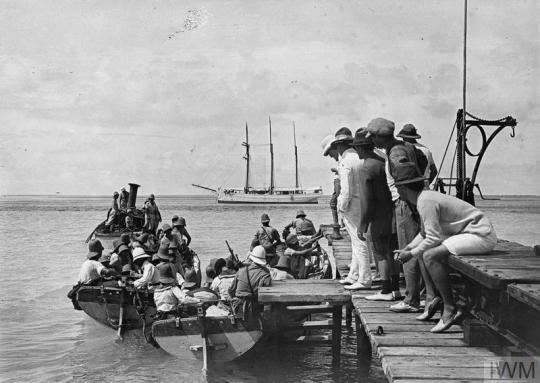
IWM Q 22707

IWM Q 22708
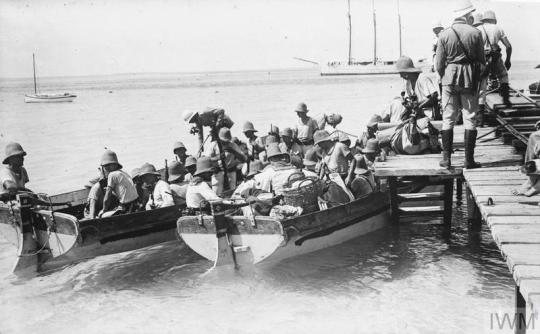
IWM Q 22725

IWM Q 22712

IWM Q 22717
The British arrive

IWM Q 22728
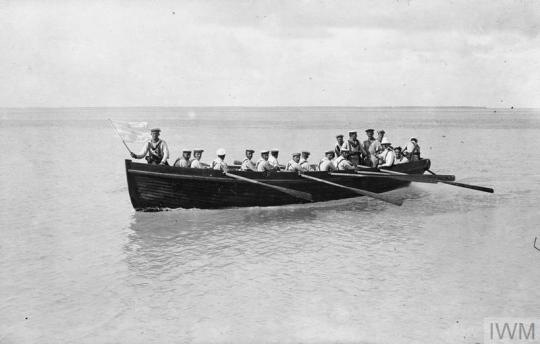
IWM Q 22722 Landing party from the British Light Cruiser SYDNEY approaching Direction Island, 9 am 10th November 1914

IWM Q 22724 - Landing party from the British Light cruiser SYDNEY on the jetty
13 notes
·
View notes
Photo

Hellmuth von Mücke (1881 – 1957)
#Illustration#military#history#editorial illustration#magazine#politikin zabavnik#ilustração#art#artists on tumblr#dedadarko
1 note
·
View note
Video
The Dresden Class cruiser SMS Emden passing underneath the Levensau High Bridge on the Kiel Canal. by ✠ drakegoodman ✠
Via Flickr:
Divided reverse. Postcard secured with the generous assistance of my German ambassador, Immanuel Voight. Emden spent the majority of her career overseas in the German East Asia Squadron, based in Tsingtao, in the Kiautschou Bay concession in China. In 1913, she came under the command of Karl von Müller, who would captain the ship during World War I. At the outbreak of hostilities, Emden captured a Russian steamer and converted her into the commerce raider Cormoran. Emden rejoined the East Asia Squadron, after which she was detached for independent raiding in the Indian Ocean. The cruiser spent nearly two months operating in the region, and captured nearly two dozen ships. In late October 1914, Emden launched a surprise attack on Penang; in the resulting Battle of Penang, she sank the Russian cruiser Zhemchug and the French destroyer Mousquet. Müller then took Emden to raid the Cocos Islands, where he landed a contingent of sailors to destroy British facilities. There, Emden was attacked by the Australian cruiser HMAS Sydney. The more powerful Australian ship quickly inflicted serious damage and forced Müller to run his ship aground to prevent her from sinking. Out of a crew of 376, 133 were killed in the battle. Most of the survivors were taken prisoner; the landing party, led by Hellmuth von Mücke, commandeered an old schooner and eventually returned to Germany. Emden's wreck was quickly destroyed by wave action, and was broken up for scrap in the 1950s. - Wiki
0 notes
Text
Landing party of the Imperial Raider SMS Emden
The Imperial Raider SMS Emden sent a contingent of sailors to destroy British facilities at Cocos Islands. While the men were ashore the Emden was attacked by the Australian cruiser HMAS Sydney on November 9 1914.
On November 10 1914 the abandoned German sailors led by Kapitänleutnant Hellmuth von Mücke decided to seize the 97-ton schooner Ayesha, which had been anchored in the lagoon and attempt to sail to the neutral Dutch East Indies.
Nov 10 1914 IWM (Q 22708) "The German landing party returning to their ship after destroying the Cable station on Direction Island" November 10 1914 Production date 1914-11-10
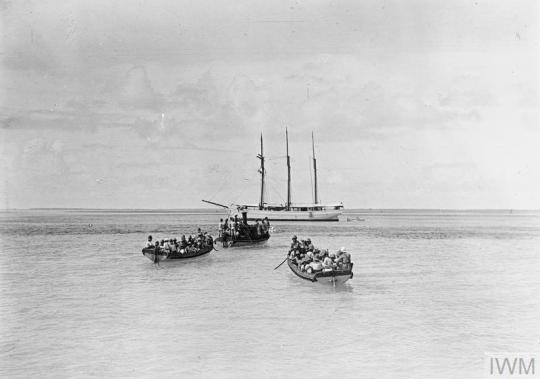
IWM (Q 22707) "A German Naval landing party preparing to leave Direction Island, the alarm being given from the [Imperial Raider SMS Emden]. 9. 30 am"
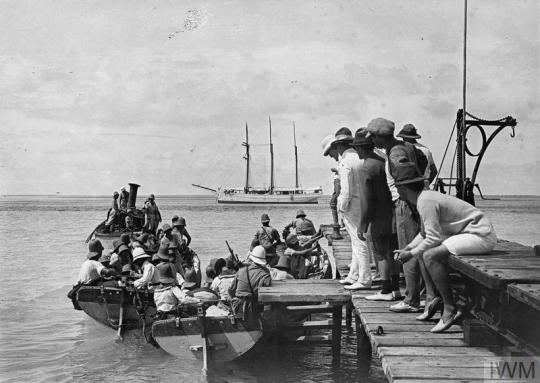
IWM (Q 22724) “Landing party from the British Light cruiser SYDNEY on the jetty at Direction Island."
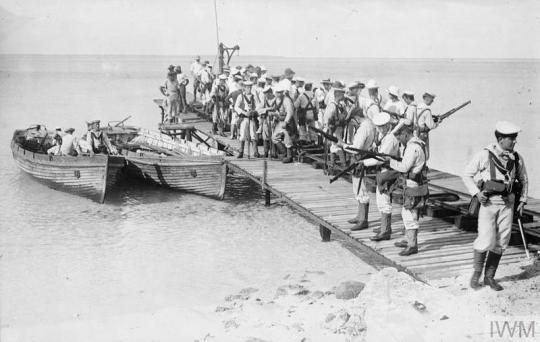
IWM (Q 22727) “The German landing party from SMS EMDEN shipping stores from the mess of the Cable Station, Direction Island"

IWM (Q 22713) “The instrument room of the Cable Station after being wrecked by the German landing party from the EMDEN, Direction Island"
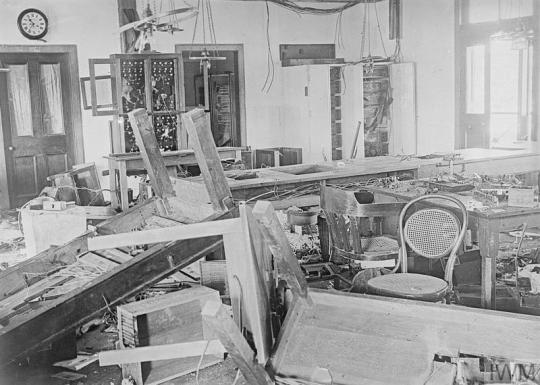
19 notes
·
View notes
